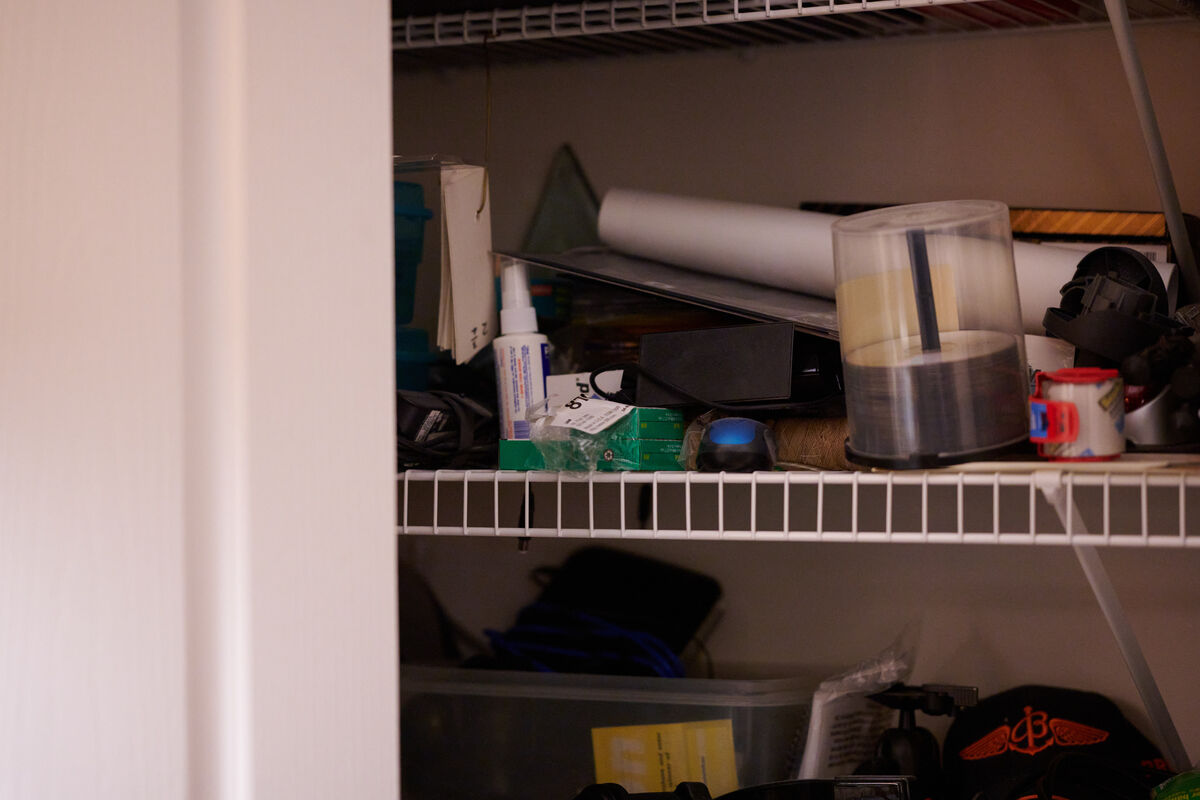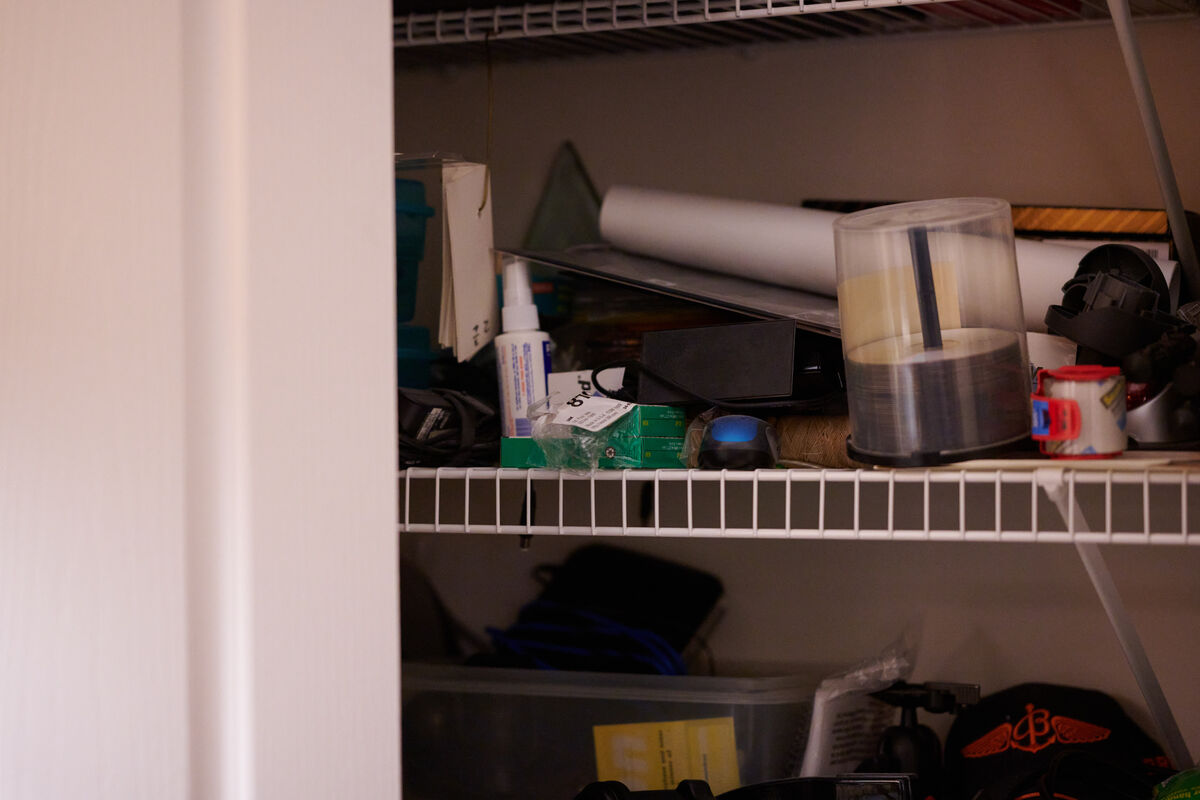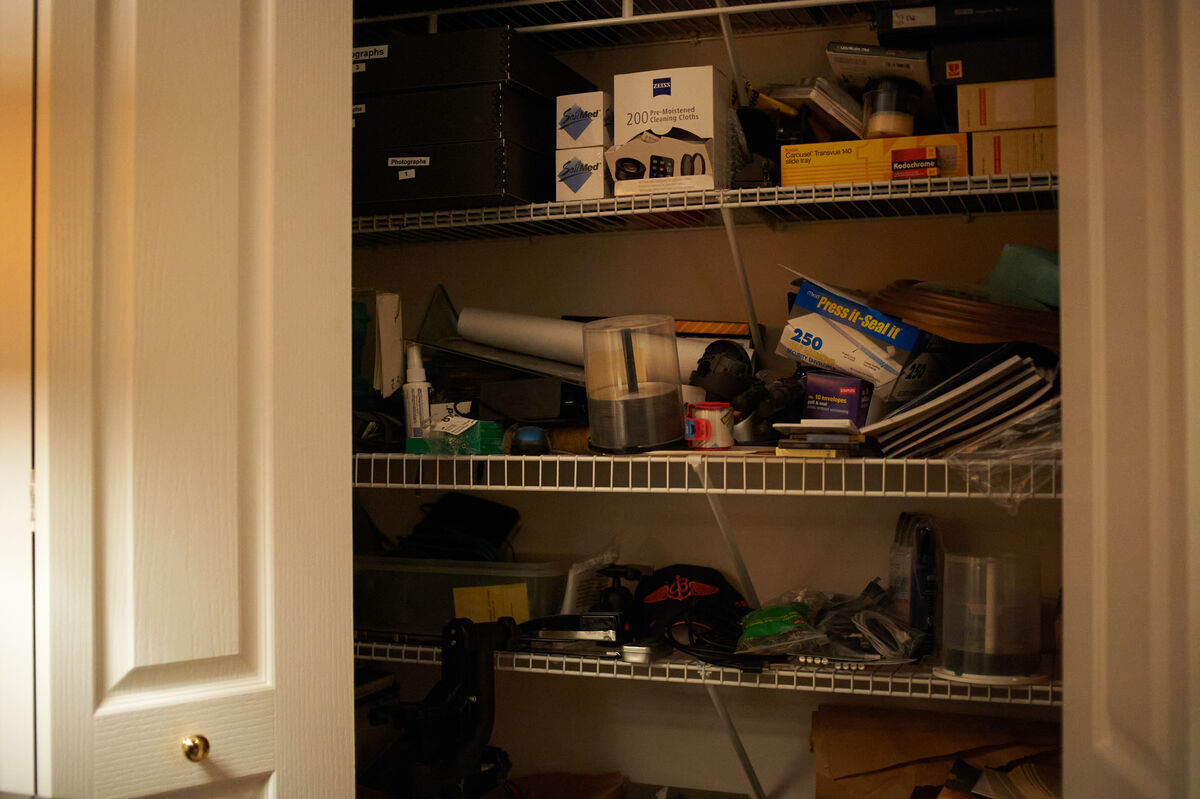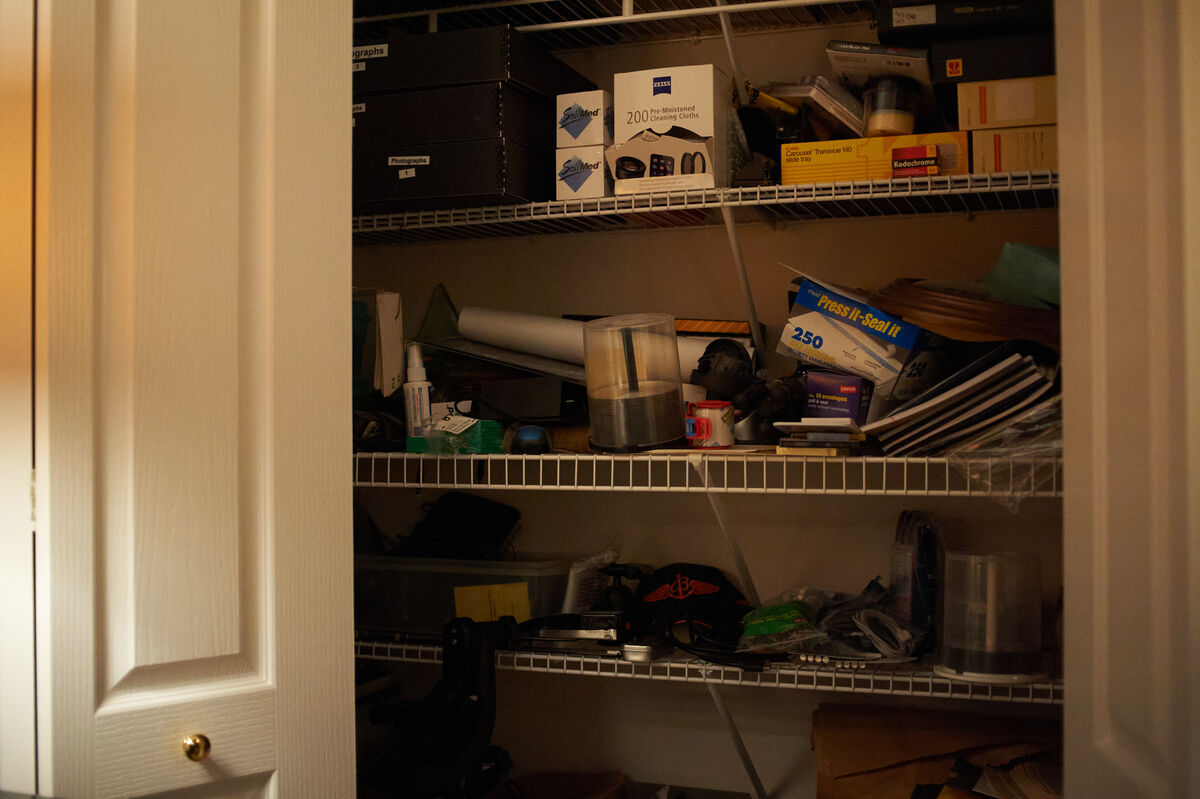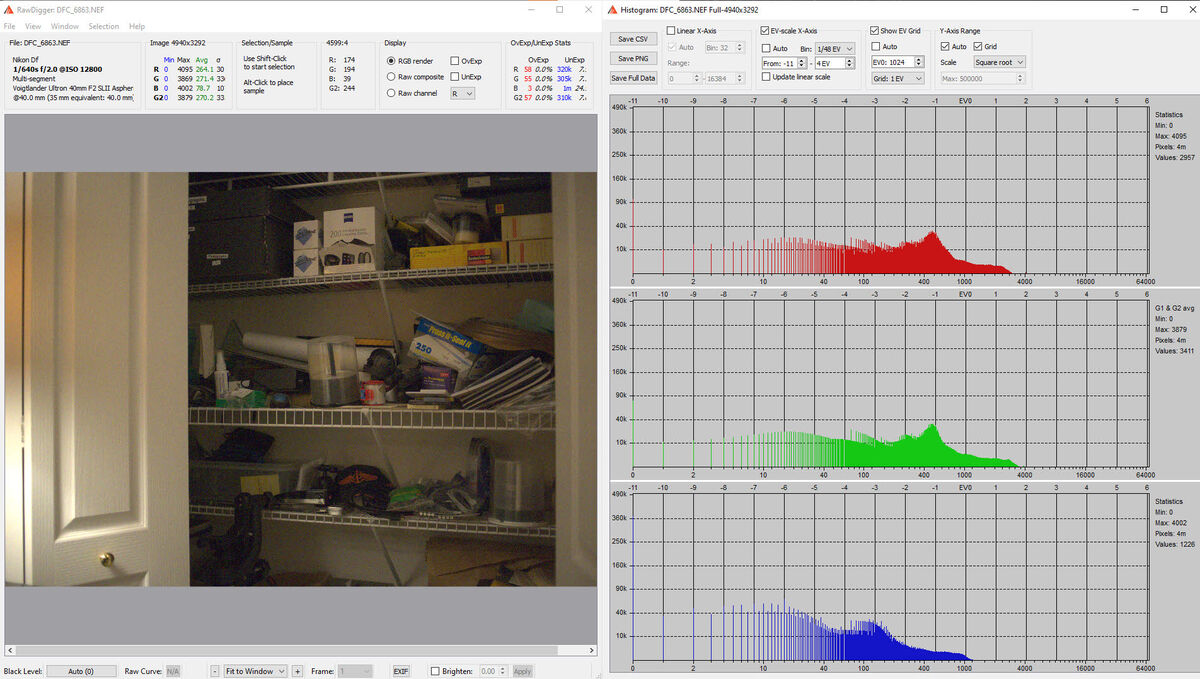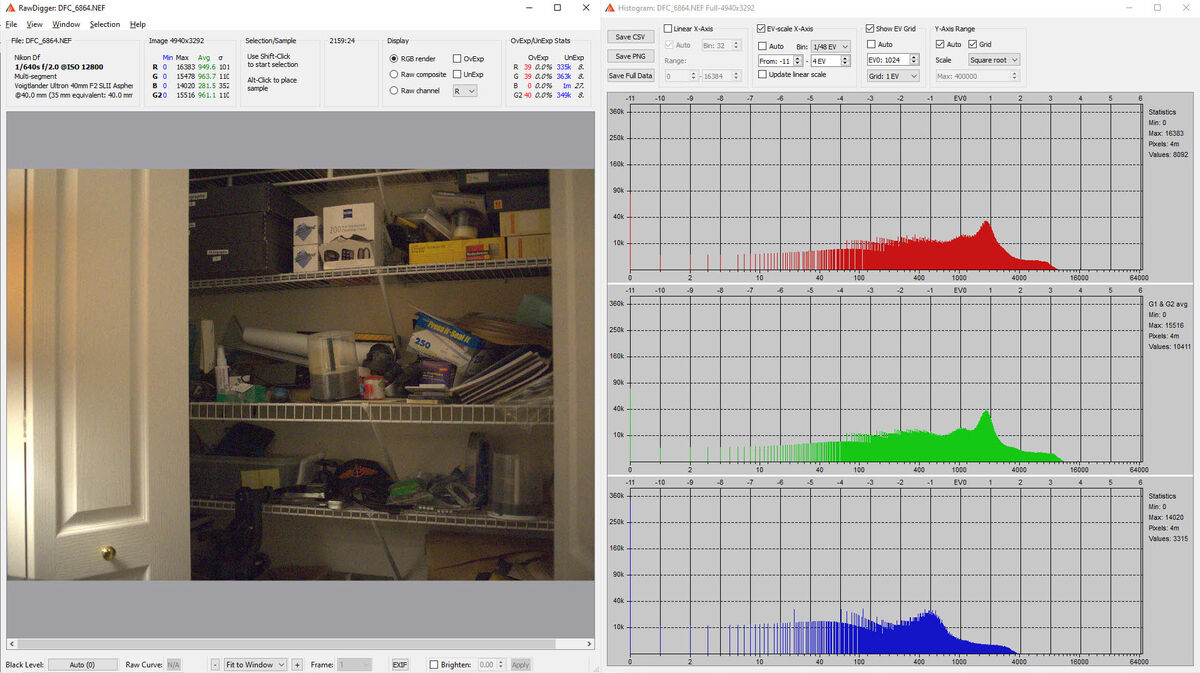Does dynamic range (DR) affect noise?
Dec 29, 2022 10:03:09 #
Or are noise and DR both affected by something else?
We know that DR drops as ISO is increased. Both DxO and Photons to Photons show this graphically. They just don't show the same DR values.
We also know that noise becomes more visible when we increase the ISO. But that's because we can use less exposure when we use higher ISO values.
To answer the original question I did an experiment using a Nikon Z7. I recorded the same low light scene at ISO 6400 by setting the raw bit depth to 12 and 14. This would produce some visible noise and two different raw dynamic ranges. Both images used the same aperture, shutter speed and white balance.
The 12-bit capture loses two stops of potential shadow recovery when compared to the 14-bit capture. It also calls for more careful exposure - to the right (ETTR).
The two images will appear in my next post. Both images were created in Capture One 23 with all settings at their default values. They are saved at 24MP (6000x4000) so they can be compared to other 24MP results.
If noise were driven by DR then we should also see a noticeable increase in noise. That did not happen.
We know that DR drops as ISO is increased. Both DxO and Photons to Photons show this graphically. They just don't show the same DR values.
We also know that noise becomes more visible when we increase the ISO. But that's because we can use less exposure when we use higher ISO values.
To answer the original question I did an experiment using a Nikon Z7. I recorded the same low light scene at ISO 6400 by setting the raw bit depth to 12 and 14. This would produce some visible noise and two different raw dynamic ranges. Both images used the same aperture, shutter speed and white balance.
The 12-bit capture loses two stops of potential shadow recovery when compared to the 14-bit capture. It also calls for more careful exposure - to the right (ETTR).
The two images will appear in my next post. Both images were created in Capture One 23 with all settings at their default values. They are saved at 24MP (6000x4000) so they can be compared to other 24MP results.
If noise were driven by DR then we should also see a noticeable increase in noise. That did not happen.
Dec 29, 2022 10:05:14 #
Please download and view at 100%.
Dec 29, 2022 10:27:09 #
Same experiment using a Df. Images are full size 16MP (4928x3280).
Dec 29, 2022 11:07:23 #
selmslie wrote:
…If noise were driven by DR then we should also see a noticeable increase in noise. That did not happen.
When confused about causation versus correlation, remember that beating a Tom Tom during a solar eclipse will always bring the sun back out.
Dec 29, 2022 11:35:45 #
TriX wrote:
When confused about causation versus correlation, remember that beating a Tom Tom during a solar eclipse will always bring the sun back out.
Was someone confused?
Incidentally, you mentioned in another thread that, "the dynamic range is defined as the difference between the noise floor and the maximum output value."
That begs the question, "What is the noise floor?" DxO, Photons to Photos, you and I don't agree on the same floor.
My view of the floor includes image size. That means that the DR changes depending on how large it is printed, something that nobody else has addressed. It's also why, when someone wants to prove that an image contains noise, they display their evidence at 100%.
Dec 29, 2022 11:54:39 #
Strodav
Loc: Houston, Tx
Your camera sensor has a maximum dynamic range. For a Z7 that's 14.57ev as measured by DxOMark.com. The cameras electronics also has a set noise value measured by taking a picture in the absence of light. That number does not change. When you have a lot of light (higher ev) the signal swamps out the noise, so you don't notice it, although noise is always part of the image. Look closely in the deep shadows for noise (and banding).
When you raise ISO you are only using the lower part of the cameras DR capability. You are telling the camera to abandon the top end, because there is no light there and amplify just the dark end to bring it up to where it is visible. That amplification can be done with the electronics or by the processor in the camera, or both. When the signal to noise ratio is low, the noise becomes more visible and when you amplify the signal + noise to make it bright enough to see, the noise is amplified with it.
You were looking for causation. It's pretty simple, the noise is inversely proportional to the number of photons in the sensor element bucket. The more photons in the bucket (higher ev) the less the noise is visible (high signal to noise ratio). The less photons in the bucket (lower ev) the more the noise is visible because you are amplifying the low light image to make it bright enough to see, hence amplifying the noise along with it.
When you raise ISO you are only using the lower part of the cameras DR capability. You are telling the camera to abandon the top end, because there is no light there and amplify just the dark end to bring it up to where it is visible. That amplification can be done with the electronics or by the processor in the camera, or both. When the signal to noise ratio is low, the noise becomes more visible and when you amplify the signal + noise to make it bright enough to see, the noise is amplified with it.
You were looking for causation. It's pretty simple, the noise is inversely proportional to the number of photons in the sensor element bucket. The more photons in the bucket (higher ev) the less the noise is visible (high signal to noise ratio). The less photons in the bucket (lower ev) the more the noise is visible because you are amplifying the low light image to make it bright enough to see, hence amplifying the noise along with it.
Dec 29, 2022 12:20:27 #
Strodav wrote:
You were looking for causation. It's pretty simple, the noise is inversely proportional to the number of photons in the sensor element bucket. The more photons in the bucket (higher ev) the less the noise is visible (high signal to noise ratio). The less photons in the bucket (lower ev) the more the noise is visible because you are amplifying the low light image to make it bright enough to see, hence amplifying the noise along with it.
I think we understand the nature of noise. Its visibility is related to the signal to noise ratio. But that's using the term "noise" in its own definition.
The ultimate source of noise is the randomness of the arrival of photons - quantum physics. The more random it is, the more noise. The randomness is greater when the total number of captured photons is small. With a larger signal (more exposure) this randomness gets swamped, hidden.
But the other thing that is usually left out is the question of magnification. It's more difficult to actually see the noise in a thumbnail or small print than in a larger depiction or at 100%.
A similar problem occurs when discussing depth of field. The DOF calculators assume a standard image viewed from a normal viewing distance like an 8x12 inch print viewed from about 12 inches. If we crop an image or change the image size or the viewing distance the DOF results are wrong.
Since print size and viewing distance are not part of the usual conversation about noise we have a similar problem.
Dec 29, 2022 13:04:04 #
A simple view:
Dynamic range is the difference between the noise floor and the saturation ceiling. Each of those has more than one contributor.
Noise floor consists of the noise from the sensor (varies with sensor factors) and processor noise (ISO level and processor factors affects this).
Saturation can happen in the sensor or the processor or both.
Raising the ISO setting raises noise levels and drops the saturation level, reducing dynamic range capability.
Dynamic range is the difference between the noise floor and the saturation ceiling. Each of those has more than one contributor.
Noise floor consists of the noise from the sensor (varies with sensor factors) and processor noise (ISO level and processor factors affects this).
Saturation can happen in the sensor or the processor or both.
Raising the ISO setting raises noise levels and drops the saturation level, reducing dynamic range capability.
Dec 29, 2022 13:07:09 #
PHRubin wrote:
A simple view:
Dynamic range is the difference between the noise floor and the saturation ceiling. Each of those has more than one contributor.
Noise floor consists of the noise from the sensor (varies with sensor factors) and processor noise (ISO level and processor factors affects this).
Saturation can happen in the sensor or the processor or both.
Raising the ISO setting raises noise levels and drops the saturation level, reducing dynamic range capability.
Dynamic range is the difference between the noise floor and the saturation ceiling. Each of those has more than one contributor.
Noise floor consists of the noise from the sensor (varies with sensor factors) and processor noise (ISO level and processor factors affects this).
Saturation can happen in the sensor or the processor or both.
Raising the ISO setting raises noise levels and drops the saturation level, reducing dynamic range capability.
Can you quantify the noise floor?
Dec 29, 2022 13:19:49 #
selmslie wrote:
Can you quantify the noise floor?
The noise floor depends on the technology and chemistry of both the sensor and processor. In real time here is no lower limit short of thermal noise. Processing can lower apparent noise.
Dec 29, 2022 13:28:29 #
Ysarex
Loc: St. Louis
selmslie wrote:
To answer the original question I did an experiment using a Nikon Z7. I recorded the same low light scene at ISO 6400 by setting the raw bit depth to 12 and 14. This would produce some visible noise and two different raw dynamic ranges.
Two different raw dynamic ranges? How so?
selmslie wrote:
The 12-bit capture loses two stops of potential shadow recovery when compared to the 14-bit capture.
How so?
Dec 29, 2022 13:41:41 #
Dec 29, 2022 15:37:33 #
Ysarex wrote:
Two different raw dynamic ranges? How so?
You surprise me. I would have thought you were already familiar with this.
Ysarex wrote:
selmslie]The 12-bit capture loses two stops of potential shadow recovery when compared to the 14-bit capture.
Ysarex wrote:
How so?
A 12-bit raw file can capture only a 12 stop range of values for each color. The highest possible raw value is 4095.
A 14-bit raw file can capture 2 more stops. The highest possible raw value is 16383.
For the same exposure, the highlights are the same distance from the upper limit.
The bottom two stops for the 14-bit raw file simply don't exist in the 12-bit raw file.
But it's the same sensor so the difference is because of the analog to digital conversion.
Dec 29, 2022 16:08:42 #
selmslie wrote:
Can you quantify the noise floor?
DxO actually does indicate something like a noise floor relative to the maximum DR of the camera.

Notice the red dashes at the DR=6 level. The closer the camera's DR gets to that level, the more noise. But is this actually the noise floor? Maybe not.
If you subtract 6 from the indicated 9.76 Ev at ISO 6400 for the Z7 you end up with 3.76 stops of net DR.
The DR values from Photons to Photos are a little different. Keep in mind that the plots from Photon to Photos are based on the information they get from DxO.

These already have taken a noise floor level into account and the DR is shown as 5.9 stops. That's only about 2 stop more than the net DR from DxO.
If you lower DxO's dotted line from 6 to about 4 you can get the two to agree more closely.
So what is the real noise floor? Who knows.

Dec 29, 2022 17:25:57 #
I’ve asked the owner of the Photons to Photos site and an expert on the subject (Bill Claff) to comment - I hope he will. Lots of assumptions here…
If you want to reply, then register here. Registration is free and your account is created instantly, so you can post right away.

